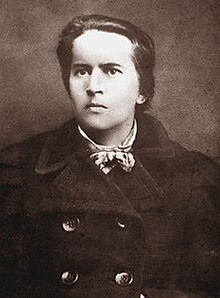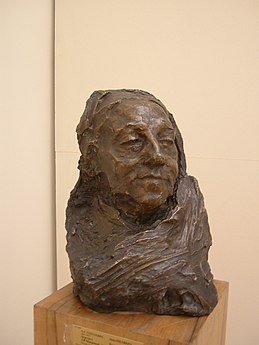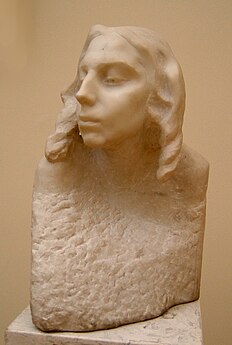Anna Golubkina
This article needs additional citations for verification. (June 2021) |

Anna Semyonovna Golubkina (
Biography
Golubkina was born in
Golubkina did not receive even a primary school education until the age of 25. Despite their total lack of formal schooling, all the children in Golubkin's family were literate and Golubkina's older sister Alexandra later got a nurse (feldsher) diploma. Golubkina's talents in painting and sculpture were discovered by the local art teacher, who recommended that she go to Moscow to study art.
In 1889 she took entrance exams for Otto Gunst's Classes for Elegant Arts, an architecture school. Having no formal education, she failed some exams; but an examiner, sculptor

The next year, the school closed due to bankruptcy. Anna entered the Moscow School of Painting, Sculpture and Architecture where she studied from 1890 to 1894 under Professor Sergey Ivanov. One of her classmates was another famous sculptor Sergey Konenkov.
In 1894-1895 she studied at the
In 1895 she went to Paris where she studied at the Académie Colarossi (1895–1897). At that time Russian artists usually went abroad either having some sort of a stipend or sufficient independent income. Golubkina was one of the first of those who came to Paris having almost no money. She literally starved but managed to produce significant sculptures including 'The Iron One'.
In 1897, she briefly returned to Russia, then became an assistant to
In 1901, she returned to Moscow. Her
Golubkina was initially very enthusiastic about the 1917
Anna Golubkina died in 1927, while working on the sculpture of Alexander Blok. She had surgery and was forbidden to handle heavy items. However, work on the large wooden sculpture required a lot of physical effort. Golubkina felt quite ill and went to Zaraysk to her sister, Alexandra Golubkina, expecting Alexandra to help her. She died a few days after arriving there.
Golubkina's studio in Moscow became a museum in 1932. It was the first Russian museum of that type.
Selected works
-
L.I. Sidorova, 1906
-
Sculptor E.D. Nikiforova-Kirpichnikova, 1908
-
E.P. Nosova-Ryabushinskaya, 1912
-
Sleepers, 1912
External links
- (in Russian) Biography




